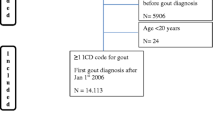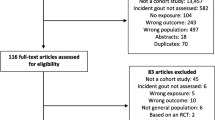Abstract
Previous reports suggested that gout incidence increased with serum uric acid (sUA) level. In addition to sUA, we aimed to examine the gender-specific risk factors for incident gout. A prospective study was conducted using data of the MJ Health Screening Center and outcome database from Taiwan’s National Health Insurance. Cox proportional hazard model was used for risk analysis of incident gout. During a mean follow-up of 7.31 years for 132,556 individuals aged ≥18 years, 1,606 subjects (1,341 men and 265 women) with clinical gout were defined. Hyperuricemia (sUA ≥7.7 mg/dL for men or ≥6.6 mg/dL for women) was the most important risk factor for gout development with a respective hazard ratio of 9.65 (95% confidence level, 8.53–10.9) for men and 9.28 (7.00–12.3) for women. The age-standardized sUA–gout relationship demonstrated a differential impact of sUA level on gout incidence between men and women. Metabolic comorbidities of hypertension, obesity, and hyperlipidemia were significantly associated with gout with respective HR of 1.32 (1.17–1.48), 1.30 (1.15–1.47), and 1.12 (0.99–1.26) for men and 1.34 (1.02–1.77), 2.15 (1.67–2.76), and 1.70 (1.32–2.19) for women. However, the relationship between diabetes and incident gout was not as prominent. The sex difference of sUA–gout relationship and the association between metabolic comorbidities and incident gout were demonstrated. Generalizability of these findings to other ethnic population needs further investigation.


Similar content being viewed by others
References
Campion EW, Glynn RJ, DeLabry LO (1987) Asymptomatic hyperuricemia. Risks and consequences in the Normative Aging Study. AM J Med 82(3):421–426
Mikuls TR, Farrar JT, Bilker WB, Fernandes S, Schumacher HR Jr, Saag KG (2005) Gout epidemiology: results from the UK General Practice Research Database, 1990–1999. Ann Rheum Dis 64(2):267–272
Underwood M (2006) Diagnosis and management of gout. BMJ 332(7553):1315–1319
Choi HK, Mount DB, Reginato AM (2005) Pathogenesis of gout. Ann Intern Med 143(7):499–516
Becker MA, Jolly M (2006) Hyperuricemia and associated diseases. Rheum Dis Clin North Am 32(2):275–293, v–vi
Bhole V, de Vera M, Rahman MM, Krishnan E, Choi H (2010) Epidemiology of gout in women: fifty-two-year followup of a prospective cohort. Arthritis Rheum 62(4):1069–1076
Harrold LR, Yood RA, Mikuls TR, Andrade SE, Davis J, Fuller J et al (2006) Sex differences in gout epidemiology: evaluation and treatment. Ann Rheum Dis 65(10):1368–1372
Hak AE, Curhan GC, Grodstein F, Choi HK (2010) Menopause, postmenopausal hormone use and risk of incident gout. Ann Rheum Dis 69(7):1305–1309
Wen CP, Cheng TY, Tsai MK, Chang YC, Chan HT, Tsai SP et al (2008) All-cause mortality attributable to chronic kidney disease: a prospective cohort study based on 462 293 adults in Taiwan. Lancet 371(9631):2173–2182
Chen JH, Chuang SY, Chen HJ, Yeh WT, Pan WH (2009) Serum uric acid level as an independent risk factor for all-cause, cardiovascular, and ischemic stroke mortality: a Chinese cohort study. Arthritis Rheum 61(2):225–232
Yang FY, Wahlqvist ML, Lee MS (2008) Body mass index (BMI) as a major factor in the incidence of the metabolic syndrome and its constituents in unaffected Taiwanese from 1998 to 2002. Asia Pac J Clin Nutr 17(2):339–351
Chang HY, Pan WH, Yeh WT, Tsai KS (2001) Hyperuricemia and gout in Taiwan: results from the Nutritional and Health Survey in Taiwan (1993–96). J Rheumatol 28(7):1640–1646
Black HR, Yi JY (1996) A new classification scheme for hypertension based on relative and absolute risk with implications for treatment and reimbursement. Hypertension 28(5):719–724
Wen CP, Tsai SP, Chung WS (2008) A 10-year experience with universal health insurance in Taiwan: measuring changes in health and health disparity. Ann Intern Med 148(4):258–267
De Souza AW, Fernandes V, Ferrari AJ (2005) Female gout: clinical and laboratory features. J Rheumatol 32(11):2186–2188
Choi HK, Ford ES (2008) Haemoglobin A1c, fasting glucose, serum C-peptide and insulin resistance in relation to serum uric acid levels—the Third National Health and Nutrition Examination Survey. Rheumatology (Oxford) 47(5):713–717
Choi HK, Ford ES, Li C, Curhan G (2007) Prevalence of the metabolic syndrome in patients with gout: the Third National Health and Nutrition Examination Survey. Arthritis Rheum 57(1):109–115
Rodriguez G, Soriano LC, Choi HK (2010) Impact of diabetes against the future risk of developing gout. Ann Rheum Dis 69(12):2090–2094
Wallace SL, Robinson H, Masi AT, Decker JL, McCarty DJ, Yu TF (1977) Preliminary criteria for the classification of the acute arthritis of primary gout. Arthritis Rheum 20:895–900
Harrold LR, Saag KG, Yood RA, Mikuls TR, Andrade SE, Fouayzi H et al (2007) Validity of gout diagnoses in administrative data. Arthritis Rheum 57(1):103–108
Malik A, Dinnella JE, Kwoh CK, Schumacher HR (2009) Poor validation of medical record ICD-9 diagnoses of gout in a veterans affairs database. J Rheumatol 36(6):1283–1286
Acknowledgments
This study was supported by the grant from the National Science Council in Taiwan (NSC97-2314-B-039-010-MY3) and that from the China Medical University Hospital (DMR-98-010). We thank the Bureau of Health Promotion, Department of Health, R.O.C. (Taiwan) for assisting in linking the MJ Health Screening Centers database to the National Health Insurance Dataset.
Disclosures
None.
Author information
Authors and Affiliations
Corresponding author
Rights and permissions
About this article
Cite this article
Chen, JH., Yeh, WT., Chuang, SY. et al. Gender-specific risk factors for incident gout: a prospective cohort study. Clin Rheumatol 31, 239–245 (2012). https://doi.org/10.1007/s10067-011-1802-6
Received:
Revised:
Accepted:
Published:
Issue Date:
DOI: https://doi.org/10.1007/s10067-011-1802-6




